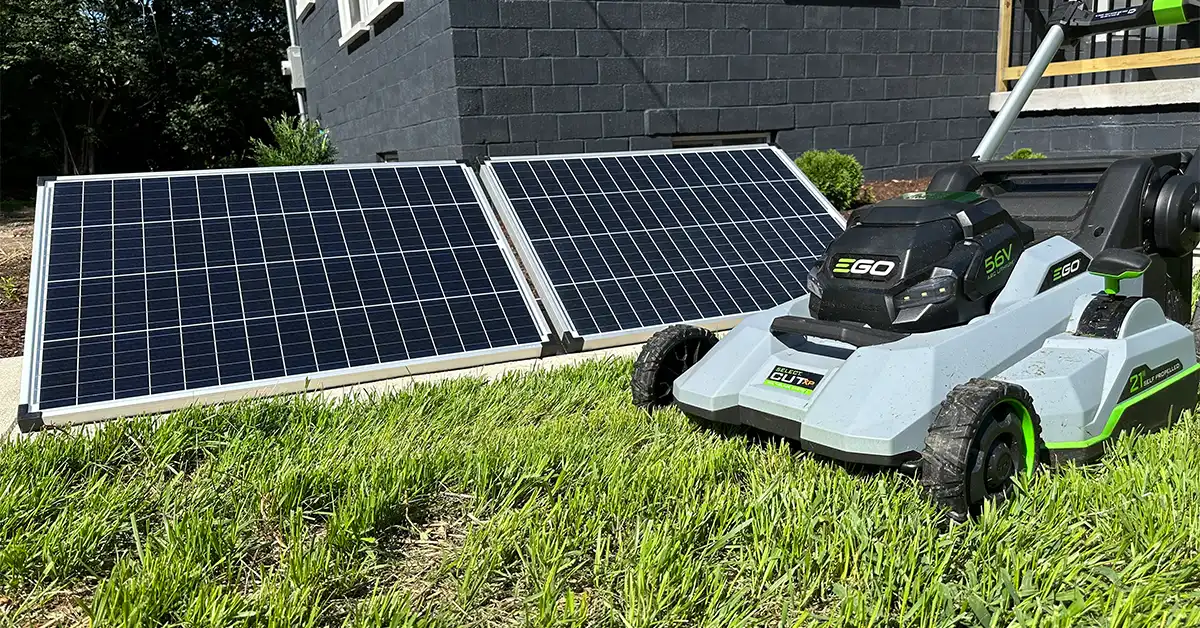If you have an off-grid shed or garage, chances are you have some battery-powered equipment you need to charge. So, let’s talk about sizing solar panels for your equipment, using an EGO lawn mower as an example.
In this guide, we’ll focus on the mower, but you can apply the same principles to any equipment you want to power. Now, let’s dive into it.
Rather watch than read? Check out this 9-minute video.
Assessing Your Load: The First Step to Sizing Solar Panels
Before we start adding solar panels to our off-grid setup, we need to understand the energy demands of our equipment. In this case, we’ll focus on a battery-powered mower.
Here are two things we’ll need to find out:
1. Maximum Battery Capacity
You’ll need to know the maximum battery capacity of your equipment. If you have the equipment with you, look for a nameplate that states the maximum battery capacity. In our case, it’s 672 Watt-hours.

2. Maximum Charger Power Draw
Determine the maximum power draw your equipment requires to charge the battery. For instance, our charger has a rating of 700 Watts. So, we need to ensure that our inverter can handle this power draw.

Using the Spreadsheet Tool for Sizing Solar Panels
Now, let’s look at how to size the solar panel system for our mower and charger using this simple spreadsheet. Remember, you can add more loads to get a complete picture of your system’s requirements.
So, let’s put that spreadsheet to work. Here are the steps:
Step 1: Identify Your Weekly Needs
We’ll focus on weekly needs for our mower, assuming you’ll mow your lawn once a week.
- Battery: Our lawn mower uses a 56-volt, 12-amp-hour battery. We’ll aim to drain it down to 80% of its capacity.
- Efficiency Factor: Consider an efficiency factor to account for conversion losses. We’ll use 90% for this example.
With these numbers, we calculate our weekly need for the lawn mower: 597 Watt-hours.

Step 2: Assess Weekly Production
Now, let’s see how many solar panels we need to meet this weekly demand. Here are the factors:
- Panel Rating: We have 100-watt panels, as shown earlier.
- Efficiency Factor: Same 90% efficiency factor.
- Daily Peak Sun Hours: In our area, we have about 4 hours of peak sun daily.
With this data, we find that one 100-watt panel can produce 2240 Watt-hours per week, which is more than enough for our lawn mower.

Step 3: Add More Loads
What if you have additional equipment, like a battery-powered riding mower, or other devices? You can add them to the spreadsheet by repeating the calculations for each load and then summing up the weekly production requirements.
For our riding mower, which uses four of the 56-volt, 12-amp-hour batteries, the total weekly need increases substantially. Using the same efficiency factor, you can calculate the number of panels needed.

A Couple Considerations
- Battery Capacity: Ensure that your battery storage, such as the EcoFlow Delta 2 in our case, is large enough to meet your demands. If you need to charge multiple devices in one day, plan for sufficient battery capacity.
- Wiring: Depending on your setup, you may need to consider the type of wiring you’ll use for your panels. Think about whether you’ll connect them in series, parallel, or a combination of both. Check out this video for solar panel wiring basics.
Planning a Larger System
If you’re thinking about scaling up to power your entire home, that’s a whole different ballgame. For larger installations, you’ll need to assess your unique needs and consult with experts who can provide accurate estimates.
So, I recommend starting with a reputable solar installer who can evaluate your home’s specific conditions, like the roof’s condition, electrical system, and more. They can also connect you with local installers for competitive quotes.
Click here for more information on this process.
Conclusion
In this guide, we’ve covered the essentials for determining the right number of panels for your off-grid solar system. Let’s sum up what we’ve learned:
- Assess Your Load
- Find the maximum battery capacity of your equipment.
- Determine the charger’s maximum power draw.
- Use the Spreadsheet Tool
- We’ve provided a handy spreadsheet to help you calculate your system’s requirements.
- This tool allows you to assess multiple loads and calculate your overall system load demand.
- Identify Weekly Needs
- Consider the frequency of using your equipment (e.g., weekly).
- Account for an efficiency factor for conversion losses.
- Assess Weekly Production
- Determine the rating of your solar panels.
- Apply the same efficiency factor for panel production.
- Consider your local daily Peak Sun Hours for accurate calculations.
- Adding More Loads
- If you have additional equipment, repeat the calculations for each load.
- Sum up the weekly production requirements to size your solar panel system accurately.
- Consider Battery Capacity
- Ensure your battery storage can meet the demands of all your devices, especially if you plan to charge them all on the same day.
- Think About Wiring
- Depending on your setup, consider the type of wiring you’ll use for your panels, whether it’s in series, parallel, or a combination.
- Professional Assistance
- If you’re planning a solar setup for your home to offset your utility bill, consult with professionals for accurate assessments and to connect with local installers.
With these steps, you can feel confident about how to get the right number of solar panels for your off-grid space. So, grab our spreadsheet, start crunching the numbers, and get one step closer to your solar-powered goals!
Thanks for joining me in this article, and if you have any questions or want to share your solar journey, feel free to leave a comment. We’re here to help you every step of the way.

